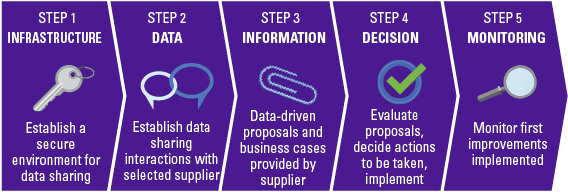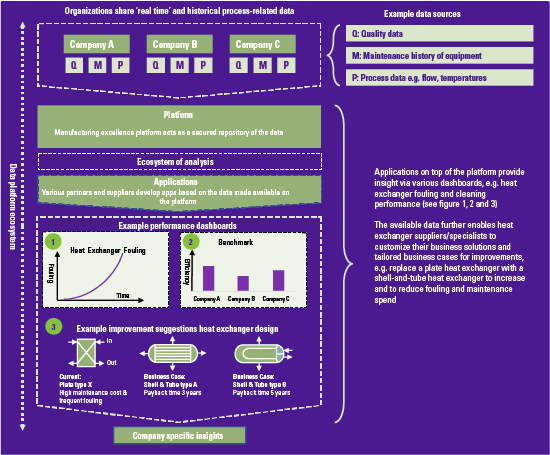Mainstream adoption of digital technologies has made the orchestration of large-scale ecosystems both feasible as well as necessary. Digital platforms should be regarded as the ‘hidden engines’ that power such ecosystems, fueled by data and using the Internet as infrastructure. Many experts in the field agree that we have entered an age where advanced intelligence and analytics become commodities – available in all industry sectors and on a global scale. Opportunities such as the ability to obtain ‘benchmarkable’ data about equipment and solutions arise. However, it will also create various challenges, for example, how to harmonize the right partners in a continuously growing ecosystem. In this article, we will further assess both the benefits and the challenges by applying the platform model as a ‘hidden engine’ to the manufacturing industry.
Introduction
As digitalization of manufacturing processes continues to expand and intensify, the supply of and the demand for manufacturing data are rapidly growing. Typical platforms such as Google and Apple have shown that customer-focused digital platforms are becoming a defining feature of the contemporary information society.
In our previous article ‘Platform thinking in manufacturing’ ([Tulk16]), the general application of ‘platform thinking’ in the manufacturing industry was explored in response to what we see as both an opportunity and a challenge. We argued that the use of digital platforms to securely share manufacturing data with external parties provides great potential for manufacturing organizations to reduce the operational costs and to improve process utilization. As outlined in our previous article, opportunities to improve manufacturing efficiency are abundant, which is why the options for platforms on the market for manufacturers is increasingly interesting. However, with those opportunities, a range of challenges arise for the manufacturing industry as it develops. In this article, we will have a closer look at these benefits and challenges by applying the platform model to heat exchangers.
In recent years, we have deduced that manufacturers increasingly acknowledge the necessity to make more extensive use of data mining tools and analytics to provide valuable insights into, for example, process inefficiencies and the proactive maintenance of equipment. However, the cost and capability of developing the appropriate tools is typically lacking within these organizations. Leaving, as research by Gartner ([Gart15]) shows, on average 70% of the data captured in the manufacturing industry unused.
Large scale data sharing via secured platforms allows suppliers and process specialists to develop customized apps that provide process/equipment performance information including benchmarking among peers. Based on the process insights, suppliers and specialists can further feed the manufacturers customized proposals to, for example, reduce maintenance cost, increase equipment reliability and utilization, reduce carbon footprint. Through this path, the available data will be turned into directly applicable improvement opportunities, using the knowledge and industry expertise that are very rarely found in-house.
During the past years, we have seen manufacturing supply chains becoming more integrated. A typical example would be the chemical cluster parks where chemical companies share feedstock (ammonia) or energy (steam) amongst each other. Data sharing and analysis to further optimize the asset and material flow optimization would provide direct benefits to all parties involved.
Solutions to facilitate manufacturing data sharing are currently being constructed. For example, Siemens and GE ([Ales17]), that are currently developing a cloud-based platform aimed at linking each stage of the manufacturing value chain across partners.
In this article, we present our views on the benefits of digital platforms for manufacturing excellence, and present a five-step approach to launch a digital platform for this purpose.
Platform benefits for manufacturing excellence
We observe that most databases in the manufacturing industry, for example, data historians, quality data reports, and maintenance systems are typically loosely intertwined. Making better use of available data requires the development of smart algorithms to mine the data. Opening the data to a range of external app developers and suppliers, via a highly secured portal, will enable the entire ecosystem to develop similar smart algorithms on top of the digital platform. The benefits of such a platform are threefold:
- The manufacturing organizations obtain customized improvement opportunities based on their data and process. The manufacturers shift their focus from ploughing through the data themselves, to selecting the improvements that will yield the most benefits to their organization.
- Suppliers will obtain ‘benchmarkable’ data on the equipment and solutions they sell in the market. For suppliers, this data is valuable for the development of new equipment and solutions and tailors the supplier’s advice on maintenance programs and business cases for process changes. Benchmarking can now take place with very similar peers across the world, providing better insights in detailed measures and indicators than benchmarking on a national scale.
- App developers have a playground to develop scalable apps in the manufacturing industry. The development of apps will be based on a large data set of various manufacturing organizations. Furthermore, the apps can quickly be adapted to new data when it becomes available due , for example, newly installed sensors. These apps comprise initial types of learning algorithms.
To demonstrate this, we will examine how this would apply to, for example, process data regarding heat exchangers in a plant that manufactures some kind of liquid product. This product needs to be heated and cooled at various stages during the process. Suppose, that a plant has increased its production volume by 10% in the last two years and now faces process downtimes due to fouled heat exchangers with a related increase in maintenance costs. What do you think happened to the plant’s utilization rate, as a result of this downtime?
Figure 1. Schematic flow: from data sources to insights. [Click on the image for a larger image]
In the plant described above, the process is equipped with various sensors (to measure, for example, flow, pressure, temperature) and their measurements are registered every few seconds in a data historian. Through maintenance systems, we can extract information about the characteristics of heat exchangers: type, year installed, internal surface, material, when it is cleaned/maintained and sometimes even blueprints. In addition, the quality measurement on the final product is registered. The plant decides to put all of the heat exchanger related data on a secure platform.
Using expertise on heat exchanger characteristics, suppliers or specialized app developers; we now have all the ingredients in place to develop algorithms to show the organization that:
- the steam heaters are fouling due to two reasons:
- fluctuations in material flows due to poor flow control settings;
- the timing for proactive cleaning of the heat exchangers is not adapted to the larger production volumes.
- the heat exchangers, that are cooling the outgoing product with the incoming product, are poor performers compared to peer plants. Hence, there is a business case for replacing these with more efficient types.
It may take months of research and development for an internal process engineer to develop the specific solutions to obtain the listed insights. In addition, it will require continual monitoring of these results and market solutions to spot when the business case for process improvement will become a viable option. Through digital platforms, where manufacturers and suppliers/partners have started to interact in the fashion described, the role of manufacturing excellence is starting to change. A new approach will focus on prioritizing the improvement suggestions and on encouraging the external parties to increase app development which will allow them to create even more diverse insights. For example, safety and environmental risks could be monitored continuously, with a proactively alert system. Moreover, product compliance issues may be predicted and control measures may be suggested by continuously learning algorithms that connect the data of the various process and reporting databases. In other words, leveraging an ecosystem of data analysts/experts through a digital platform will enable the manufacturing excellence department to achieve results in multiple improvement areas at the same time.
What ingredients are needed to get started?
Becoming connected to a platform that will expose you to a broad ecosystem has significant technical implications for your business. We will explore this in our five step approach below. Based on our experience, we can conclude that successful implementations of platforms are generally characterized by a strong vision of the organization that is required to make the digitization leap. The journey has to start with the development of a strategic roadmap, governed by empowered leaders in the organization. These leaders should have a clear focus on getting the organization ready to scale up the platform as quickly as possible once the first successful interactions have been established. Pricing strategies are adapted accordingly, in response to or in anticipation of changes in the manufacturing industry and the market. Dedicating an entrepreneurial team of platform experts, cyber security specialists, change managers and supplier managers, is a key requirement for achieving maximum benefit.
Using a five step approach, we will briefly describe which steps need to be considered to successfully launch your manufacturing excellence platform.

Figure 2. Five step approach to launch a manufacturing excellence platform.
- It is essential that you choose a ‘custodian’ to create and exchange value units on your platform. Typically the custodian is an independent body that focuses on the creation of new requirements for integration, data standards, security, compliance and reputation risk, alongside a governance structure that ensures equitable platform behavior by participants.
- The first interactions on the platform need to be established. The first interaction should provide a value-based exchange between one or more participating parties (e.g. manufacturing companies, specialists, suppliers). A broad understanding of the components of the ecosystem is required to develop a successful platform.
- The loop between the data users (supplier/partners) and the data providers (manufacturing organizations) needs to be closed. Heat exchange experts, for example, will use their expertise and analytics on the equipment and processes to provide a deeper layer of insight and to harmonize the data. Suppliers are enabled to further customize their breadth of solutions, and to define business cases tailored to your specific business and processes.
- An appropriate decision-making process needs to be in place to ensure proper prioritization of suggested improvements. This implies that the manufacturing excellence departments will focus on filtering proposals, and coordinate the implementation of the selected solutions.
- Finally, the implemented equipment/process improvements will be monitored in real time to ensure the performance. The data link to enable real time performance monitoring can be established directly on the platform by the implementers of the improvements.
During the journey, as outlined in the five steps above, there are a number of critical factors that enable manufacturing organizations to maximize the benefits from such a digital platform:
- Trust is pivotal in determining a digital platform’s success. Data security may be a significant concern when it comes to protecting sensitive data in an external environment, e.g. manufacturers worldwide are becoming more interested in knowing which partners have access to and can profit from their manufacturing data. The internal data management and information security policies and standards (e.g. management of change protocols, ownership of data) in your organization need to be structured in a way that sufficient data may be shared whilst minimizing the risk of potential data leaks. A custodian should therefore safeguard data security and should have a clear vision on the application and segregation of data. The data of the different participants need to properly segmented by Chinese walls, otherwise it will undermine the willingness by companies to provide their sensitive data for benchmarking purposes.
In addition to ensuring trust by strong security controls, trust also is strongly dependent on high data quality and platform reliability. - Put mechanisms in place to ensure that participants have little to no doubt about conducting business on the platform. You need to decide how easily others can plug into the platform to share and transact. By building a digital platform, other businesses can easily connect their business to yours, build products and services on top of it, and co-create value. A custodian needs to carefully manage who enters the platform. The market conditions and anti-trust restrictions in your industry sector or country may determine which type of platform will be viable for creating a first-mover advantage:
- supplier-led;
- neutral (sector-wide, for example established by industry association, IT provider);
- customer-led (by dominant supply chain party, the sector leader).
- Common data standards on the data to be shared to increase the amount of information that can be distilled. Proper definition of common data standards works two ways: externally, the equipment and process performance can be better benchmarked to peers/competitors; internally the various databases containing process performance information can be combined and various data components can interact. Besides standardization of the data exchanged, detailed benchmarking will also require data normalization as full harmonization of manufacturing data in ERP and MES systems across the supply chain is usually difficult to achieve.
- An adapted operating model for the manufacturing organization to ensure smooth operation in an ecosystem. Sharing data and putting an ecosystem at work for you to analyze your data and divulge specific proposals for improvement is different from managing a selection of suppliers and consultants. A platform is about managing interactions and fueling the power of network effects.
Conclusion
Multiple industries have proven that valuable digital platforms can be established among suppliers and competitors. Enterprises in other sectors, for instance the ‘Neutraal Logistiek Informatie Platform’ (NLIP – Neutral Logistic Information Platform)1 in the logistics industry or the Philips HealthSuite2 digital platform in the healthcare industry, have shown that connecting various parties to orchestrate data in an industry via a platform is possible.
The concept applied to the manufacturing industry is promising, as we are entering an age where the intelligence and analytics are mutually aligning. The real challenge, if we may be so bold, lies mostly in overcoming the conservative mindset of the manufacturing community to harmonize the right partners in a continuously growing ecosystem. Once the digital platform is up and running, it is will be very hard to compete against because the power of network effects will protect them from classical competition (‘winner takes all’ also applies in the B2B market).
A strong digital platform will first support participating companies to improve their (internal) manufacturing excellence, but over time will generate possibilities to improve the supply chain processes.
Notes
- The NLIP can be earmarked as a logistics industry changer by facilitating the dissemination of information/data through the entire chain. See http://www.nlip.org/nlip/.
- The Philips HealthSuite is an open cloud-based platform which harmonizes data from various medical devices to enable continuous healthcare innovation and the development of personalized care applications. See http://www.usa.philips.com/healthcare/innovation/about-health-suite.
References
[Ales17] C. Alessi, GE, Siemens Vie to Reinvent Manufacturing by Harnessing the Cloud, Fox Business, March 5, 2017, http://www.foxbusiness.com/features/2017/03/05/ge-siemens-vie-to-reinvent-manufacturing-by-harnessing-cloud.html.
[Gart15] Gartner, Predicts 2016: Opportunities Abound for the Factory to Reach Its Potential, 2015.
[Tulk16] R. Tulkens, S. Klous, J. Pasman and M. Boute, Platform thinking in manufacturing: A fresh alternative to Manufacturing Excellence, KPMG, 2016, https://assets.kpmg.com/content/dam/kpmg/nl/pdf/2016/sector/maakindustrie/Platform-thinking-in-manufacturing.pdf.






